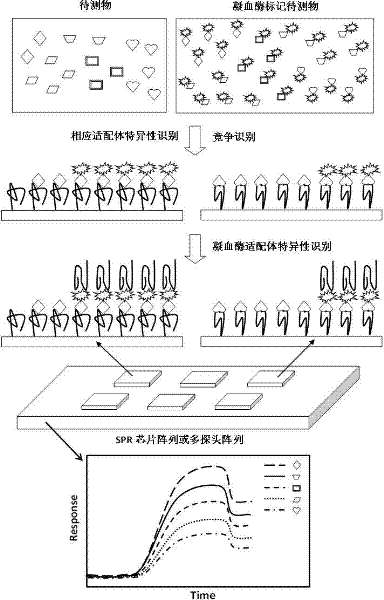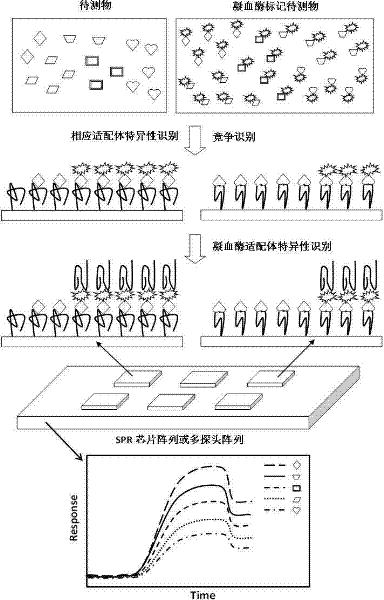Method for detecting multiple harmful substance residual components in food based on surface plasma resonance technique
A surface plasmon and surface plasmon technology, which is applied in measuring devices, scattering characteristic measurement, and material analysis through optical means, can solve problems such as the difficulty of detecting multiple low molecular weight substances at the same time, achieve ultra-sensitive detection, and improve the use of The effect of shortening the life and shortening the sample detection time
- Summary
- Abstract
- Description
- Claims
- Application Information
AI Technical Summary
Problems solved by technology
Method used
Image
Examples
Embodiment
[0028] Example: Thrombin is selected as the molecular probe, and the thrombin aptamer sequence is: GGTTGGTGTGGTTGG.
[0029] Five small molecular harmful substances in typical foods were selected as detection objects, namely acetamiprid, kanamycin, oxytetracycline, ochratomycin, and malachite green, and the corresponding aptamer sequences were:
[0030] Acetamiprid aptamer - CCTGCCACGCTCCGCAAGCTTTGTAATTTGTCTGCAGCGGTTCTT
[0031] GATCGCTGACACCATATTATGAAGATAAGCTTGGCACCCGCATCGT
[0032] Kanamycin aptamer - CACCTAATACGACTCSCTATAGCGGATCCGAAGATGGGGGTTG
[0033] AGGCTAAGCCGACCGTAAGTTGGGCCGTCTGGCTCGAACAAGCTTGC
[0034] Oxytetracycline aptamer - CGTACGGAATTCGCTAGCCGAGTTGAGCCGGGCGCGGTACGGGT
[0035] ACTGGTATGTGTGGGGATCCGAGCTCCACGTGGGATCCGAGCTCCACGTG
[0036] Ochratoxin aptamer - GATCGGGTGTGGGTGGCGTAAAGGGAGCATCGGACA
[0037] Malachite green aptamer - GGAUCCCGACUGGCGAGAGCCAGGUAACGAAUGGAUCC.
[0038] The specific operation steps are as follows:
[0039] (1) Aptamer immobilization on...
PUM
 Login to View More
Login to View More Abstract
Description
Claims
Application Information
 Login to View More
Login to View More - R&D
- Intellectual Property
- Life Sciences
- Materials
- Tech Scout
- Unparalleled Data Quality
- Higher Quality Content
- 60% Fewer Hallucinations
Browse by: Latest US Patents, China's latest patents, Technical Efficacy Thesaurus, Application Domain, Technology Topic, Popular Technical Reports.
© 2025 PatSnap. All rights reserved.Legal|Privacy policy|Modern Slavery Act Transparency Statement|Sitemap|About US| Contact US: help@patsnap.com


